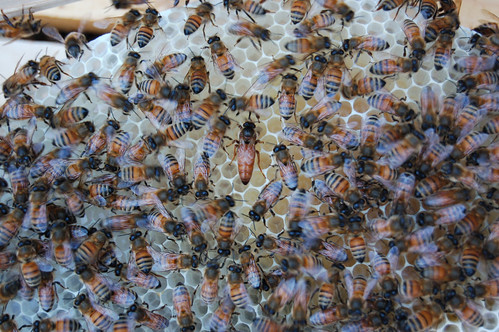The Magnolia Queen
...

Today I did an in-depth inspection of the Gloriana hive, and pulled a frame full of capped honey to give to the new colony that I cut out of the magnolia tree in San Lorenzo.
That colony is small, but mighty. They've been in the their new hive box just eight days, and already they're building beautiful white wax comb.
One nice thing about a small colony: there's a chance that we'll spot the queen. I swear, I never see the queens in my two big hives. There are just too many bees, and it takes so long to go through all the frames that the queen has plenty of time to vamoose.
Can you see her? She's the largest, reddest bee. She's dead-center in my photograph, with a bit of space on all sides.

In pouring over my photographs, I realized that the Magnolia queen is already laying eggs, and some of those eggs have hatched into larvae. She must have gotten to work the instant her retinue had built the first comb.
Robb and I had assumed that this queen was a virgin queen, and that we'd have to wait for her to make her mating flight before she started laying. We're delighted to be proved wrong in our assumptions. If this queen is already laying eggs, the colony stands a better chance of building up a large enough population to make it through the winter.
Of course, winters around here aren't particularly rough, but the hive does need a critical mass for survival.
Good for you, Magnolia Queen!

Today I did an in-depth inspection of the Gloriana hive, and pulled a frame full of capped honey to give to the new colony that I cut out of the magnolia tree in San Lorenzo.
That colony is small, but mighty. They've been in the their new hive box just eight days, and already they're building beautiful white wax comb.
One nice thing about a small colony: there's a chance that we'll spot the queen. I swear, I never see the queens in my two big hives. There are just too many bees, and it takes so long to go through all the frames that the queen has plenty of time to vamoose.
Can you see her? She's the largest, reddest bee. She's dead-center in my photograph, with a bit of space on all sides.

In pouring over my photographs, I realized that the Magnolia queen is already laying eggs, and some of those eggs have hatched into larvae. She must have gotten to work the instant her retinue had built the first comb.
Robb and I had assumed that this queen was a virgin queen, and that we'd have to wait for her to make her mating flight before she started laying. We're delighted to be proved wrong in our assumptions. If this queen is already laying eggs, the colony stands a better chance of building up a large enough population to make it through the winter.
Of course, winters around here aren't particularly rough, but the hive does need a critical mass for survival.
Good for you, Magnolia Queen!

Comments
We have had a small but persistent clump of workers hanging together on one of the okra plants. We looked for a queen. I guess they're republican bees. They've been there for weeks now. I'm careful when I water, hope they find a good place to spend the winter, because the okra won't make it.
When you keep bees, can you really tell that there are hundreds of them living maybe 5 to 10 yards away from you're walking in your garden? They fly to flowers maybe a mile away, I bet you can't tell if you're not looking directly at the hive, right? I think my husband is afraid he'll feel like there's a constant fog of bees everywhere.
Does our neighbor have fences like that between him and his other neighbors, or just you? Is his the house visible in the background of the working on redwood siding photos - the one with bars on all the windows - maybe he is excessively afraid of burglars getting into his yard?
http://www.fs.usda.gov/Internet/FSE_DOCUMENTS/stelprdb5306468.pdf
Those bees look pretty happy and sweet new comb. I decided to start letting the bees build their own foundation also. Read you need a starter strip about 1/8 x 3/4 inch. Guess it'll be next year before I try myself. Tried a bee extraction a few weeks ago, but the bees were in a brick column and not under the porch..